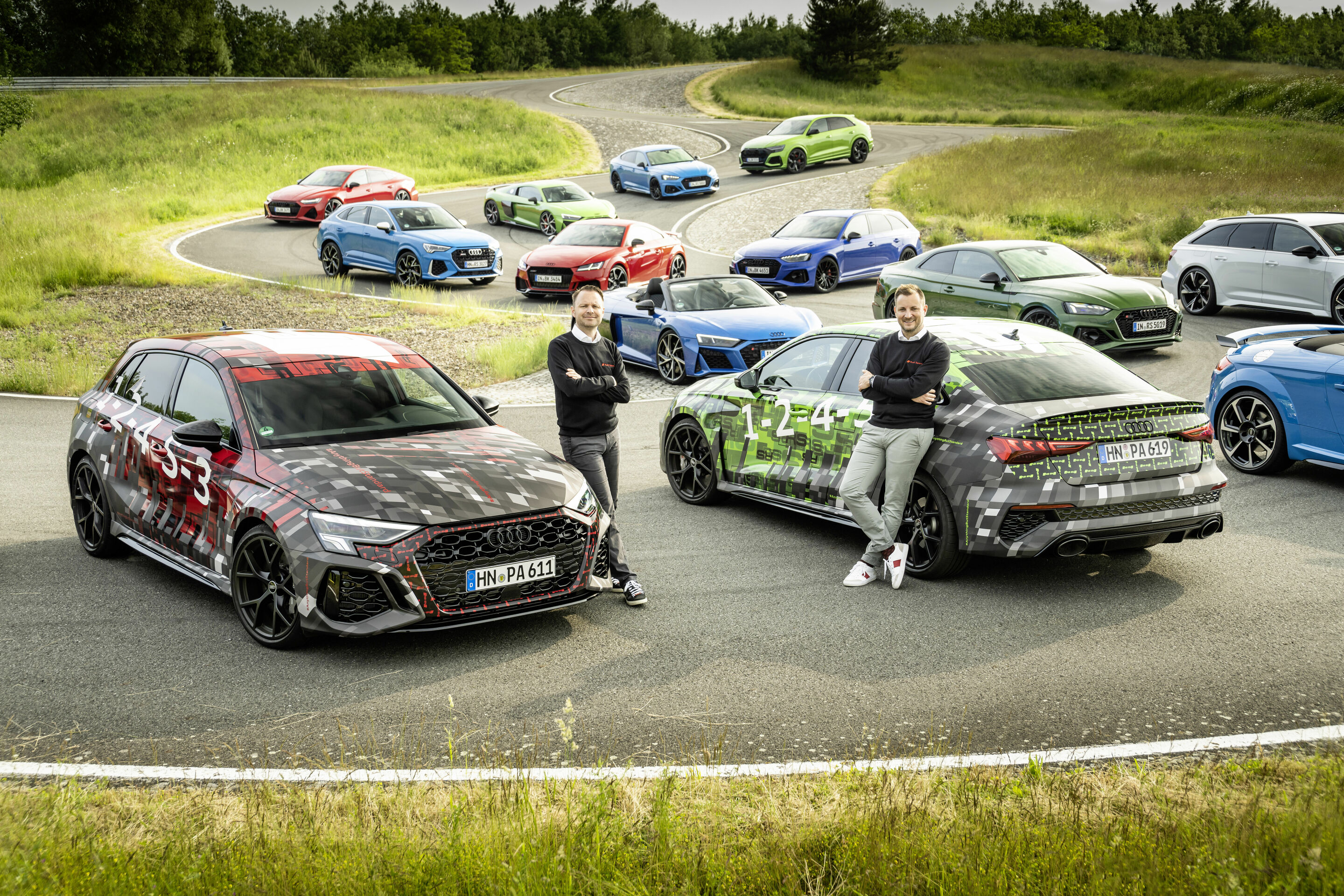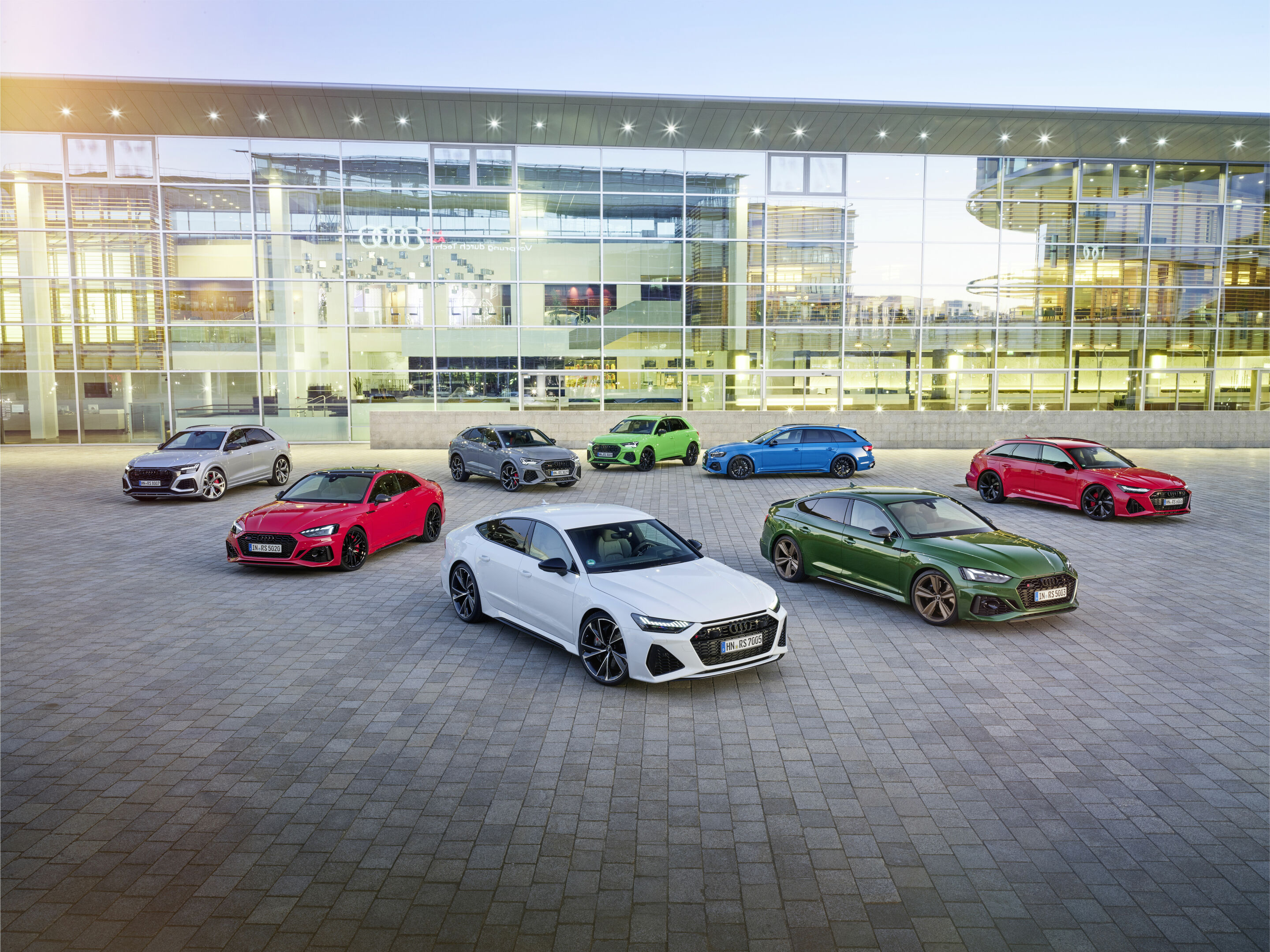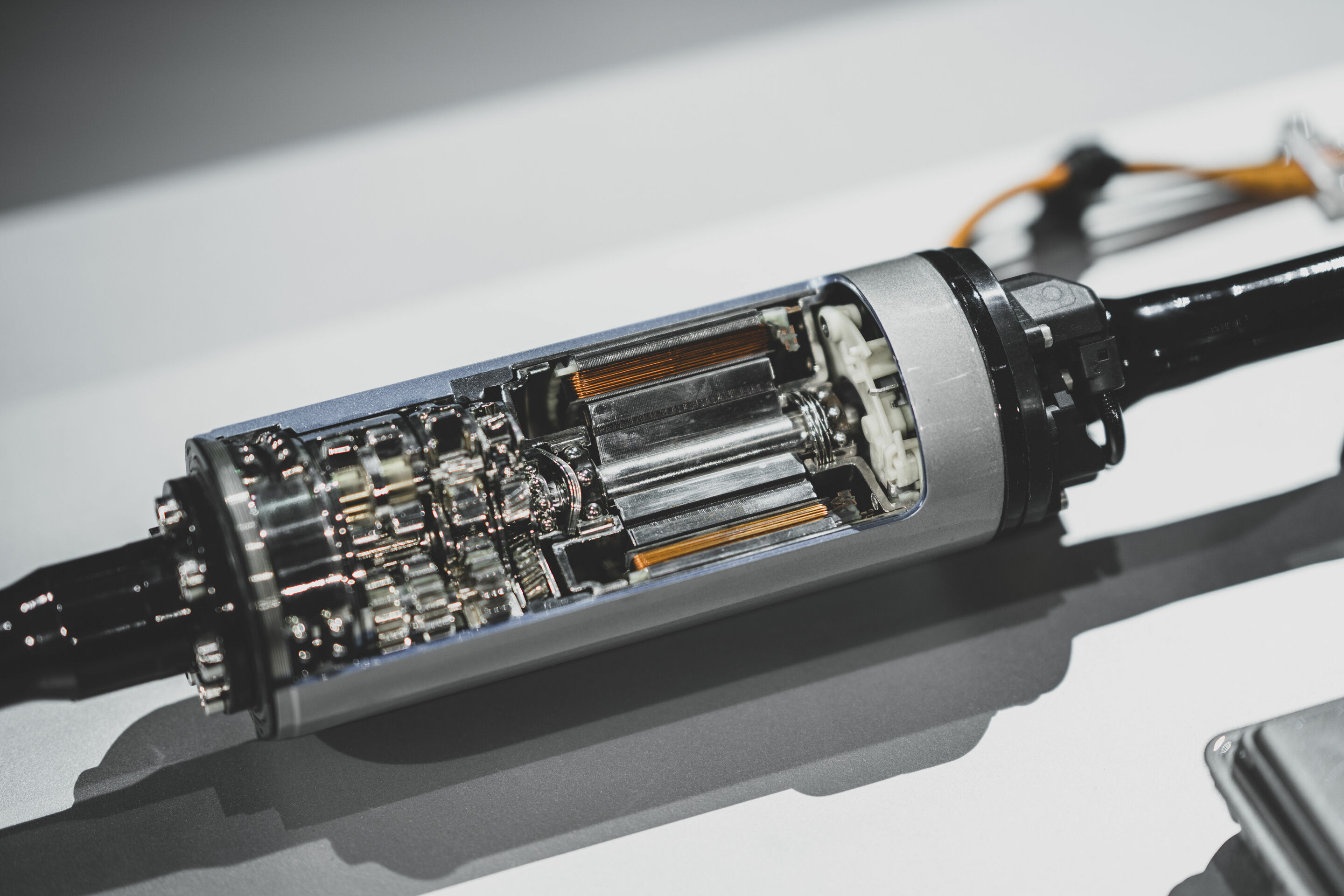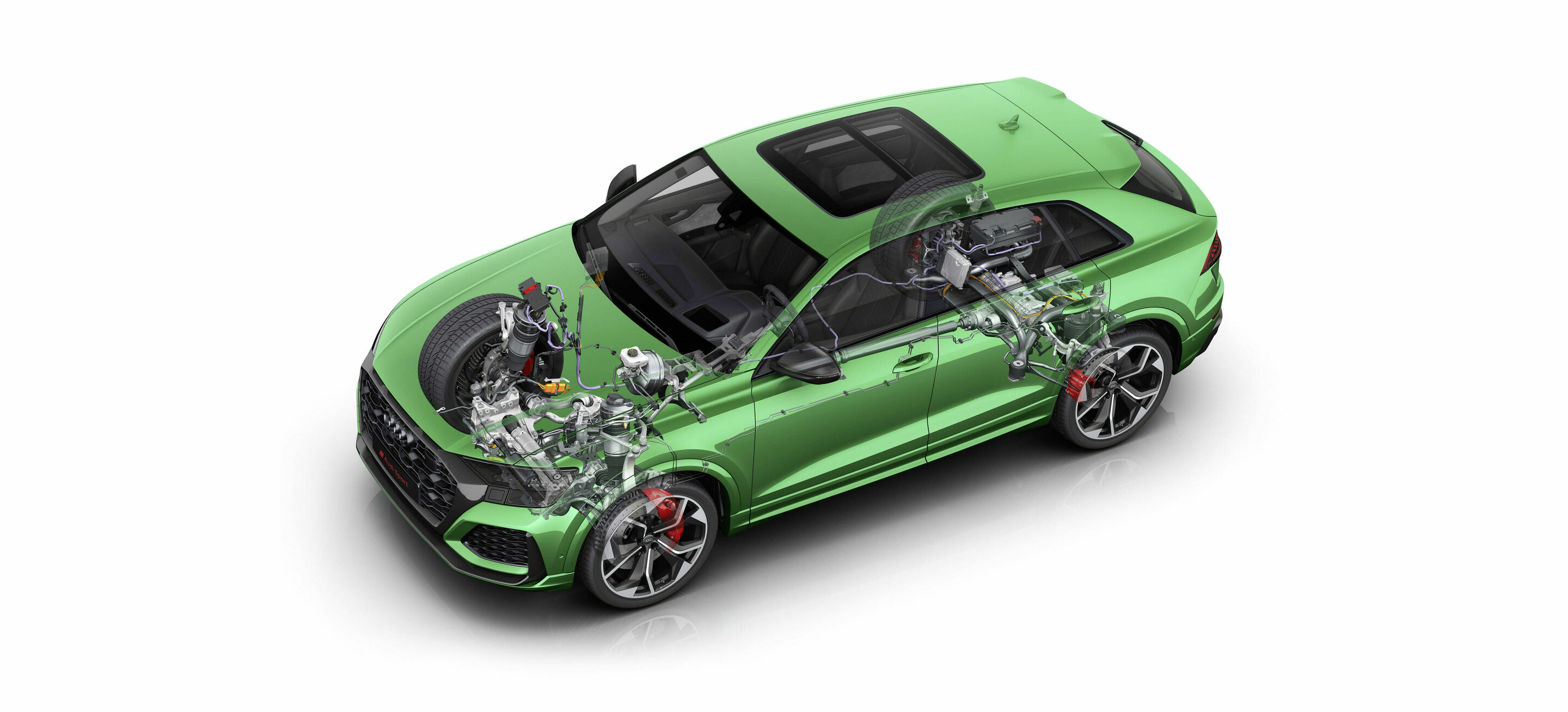Search
All results
(376)
MediaInfos
(8)
BasicInfos
(2)
Press kits
(2)
Images
(321)
Videos
(16)
Publications
(5)
Technical Details
(3)

With 471 kW (640 PS) and 850 Nm of torque, the RS Q8 performance is the ideal companion on the winding country roads of Spain and the ParcMotor Castellolí The suspension components secure the RS Q8 performance the title of record holder on the Nordschleife and also ensure first-class driving pleasure off the racetrack Chassis developer Roland Waschkau: "The RS Q8 performance perfectly combines suitability for everyday use and sporty attributes"
The sun is already hovering over the Mediterranean, the temperature is in double digits, and the conditions are almost ideal. We meet Roland Waschkau, responsible for the chassis development of the RS Q8 performance, in front of the hotel in Sitges. He points to the most powerful production vehicle with a combustion engine in Audi's history. His enthusiasm for the car is written all over his face. "The RS Q8 performance combines everyday practicality and sporty attributes like no other vehicle," enthuses the developer. The new performance version of the RS Q8 is the highest configuration level of its model series.

With 471 kW (640 PS) and 850 Nm of torque, the new RS Q8 performance takes the top position among models from Audi Sport GmbH An expressive exterior and new, lighter* wheels significantly sharpen the appearance of Audi’s most powerful SUV yet again With a time of 7:36.698 minutes, the RS Q8 performance sets a new best time for production SUVs on the legendary Nürburgring Nordschleife circuit Audi Sport boss Rolf Michl: "The RS Q8 performance owes its lap record to the interplay of the V8 engine and chassis components as well as the passion of the Audi Sport GmbH team for absolute performance."
Audi is rounding out the Audi Q8 model range, not only with the new RS Q8 with an output of 441 kW (600 PS) but is adding a new, second version to the top model in the series: the RS Q8 performance . Its increased output of 471 kW (640 PS) makes the SUV the most powerful series-produced combustion model in the history of Audi Sport GmbH. Both vehicles boast outstanding driving dynamics thanks to an optimized, self-locking center differential while guaranteeing an equally impressive suitability for everyday use.
 Marc Lichte: “Good design and true progress can only come from real passion”
Marc Lichte: “Good design and true progress can only come from real passion”
After ten years as Head of Audi Design, Marc Lichte is seeking new impulses outside the VW Group His design language will continue to shape the model range for a long time to come Marc Lichte: “The most important project is always the next one”
He stands for reduced shapes, courageous thinking, and untiring passion, traits with which he designed more than 150 vehicles over the past 28 years. For an entire decade as Head of Design at the premium manufacturer Audi, Marc Lichte (54) was responsible for exterior and interior design and designing the brand’s racecars as well as for UI/UX design, which is becoming increasingly relevant for connected vehicles. During his tenure, Audi Design was honored with numerous international awards. On June 1, Massimo Frascella is slated to succeed Lichte, who will leave the VW Group to seek new creative impulses elsewhere. His design language will continue to shape the model range of the manufacturer from Ingolstadt for a long time to come.
As Head of the Exterior Studio at Volkswagen, Marc Lichte designed the epitome of automotive functionality with the Golf series V, VI, and VII. In 2014, he gave the brand with the four rings a preview of his design vision with his first concept cars, the Audi prologue and the Audi Q8 concept. Whether elegant classic cars such as the luxury sedan Audi A8 or sporty vehicles such as the RS 6 and RS Q8 – ten years later, all model generations embody Lichte’s clear vision of a reduced design language with its timeless and long-lasting impact. In February 2021, the premium brand introduced a fully electric Gran Turismo, the Audi e-tron GT – to Lichte it is “the most beautiful car I ever designed.”
 Red rhombus meets “Green Hell”: 40 years of Audi Sport GmbH with a special kick-off at the Nürburgring
Red rhombus meets “Green Hell”: 40 years of Audi Sport GmbH with a special kick-off at the Nürburgring
Audi subsidiary celebrates its 40th birthday this year Oliver Hoffmann: “We have a clear goal: to successfully carry the sporting DNA of the four rings into the electric future” Rolf Michl: “The Nürburgring is a magical place for us” Sebastian Grams: “We want to shape the future of mobility in the high-performance segment in a sustainable and progressive way”
Almost 40 years ago – on October 10, 1983 – Audi Sport GmbH, as it is known now, was founded as quattro GmbH. Today, it shapes the sporty and exclusive image of the brand with the four rings. At Audi, the vehicles with the red rhombus stand for performance and sportiness. The birthday celebrations begin at the Nürburgring 24 Hours next weekend (May 18–21).
40 years, more than 250,000 vehicles produced in the past ten years alone and more than 400 clinched motorsport titles meet 20.832 kilometers, 73 turns and elevation changes of more than 300 meters – key figures that stand for Audi Sport GmbH and also the legendary Nordschleife – also known as the “Green Hell” – of the Nürburgring. This has shaped Audi Sport GmbH like no other race track. The circuit in the Eifel region and the wholly owned subsidiary of AUDI AG share a close relationship – both in racing and in the high-performance vehicles of the series. Audi Sport has been an official partner of the 24-hour race since 2002 and provides the “official cars” to the race organizers. Since 2009, the Audi R8 LMS has been competing in the Eifel marathon, which is one of the annual highlights of Audi Sport customer racing. The customer racing division has been part of the former quattro GmbH since 2011. With six overall victories and three additional GT3 class wins to date, Audi is the most successful manufacturer in the GT3 era of the endurance classic at the “Green Hell.”

Audi Sport GmbH now has largest product range ever Delivery figures for R and RS models hit record high Systematic electrification strategy in the high-performance segment
Audi Sport GmbH had an epic year in 2020, delivering more than 29,300 vehicles to customers – a new record for the high-performance carmaker. With more than 15 R and RS models currently available, it now boasts its largest product range ever. And with its RS e-tron GT, Audi Sport has also succeeded in entering the all-electric world. In this interview, the company’s new Managing Director Sebastian Grams and Rolf Michl, Head of Sales and Marketing, explain the technological potential offered by electrification and what this means from a sales perspective.
Sebastian, you’ve been a member of the management team at Audi Sport GmbH since the first of March. Politicians are traditionally asked to provide an initial assessment after 100 days in office. What was this period of time like for you? Sebastian Grams: I’m a native of Heilbronn in Germany and began my career here at Audi 20 years ago in the field of drive development. I can promise you that there isn’t a child in this region who doesn’t dream of working at Audi Sport. Like everyone on our team, I’m a performance enthusiast and extremely passionate about technology. Our mission is to push the limits of what’s possible – that’s what Audi Sport is all about. And I’m positive that this will continue to be the case in the future. Speaking of limits, what do you think it takes to break new ground? Sebastian Grams: Change begins, first and foremost, in the mind.

He is connected with the history of Audi Sport like no other racing driver. His greatest accomplishments include winning the 24 Hours races of Spa in 2012 and the Nürburgring (2012 and 2019). Stippler was part of the team right from the start, when the GT3 racing car Audi R8 LMS debuted in 2009. Aside from his skills as a driver, he also contributed his engineering expertise. Ever since then, it has been hard to imagine the development of customer sport racing cars and even sporty road models without him. This applies to the RS models as well as the R8** high-performance sports car, which was extensively updated at the beginning of 2019 – as Coupé**, as Spyder**, and as an R8 V10 RWD** with rear-wheel drive. Stippler’s latest coup is a lap record on the North Loop, which he set with an RS Q8** in the fall of 2019. The clock stopped after 7 minutes and 42.253 seconds – attested by a notary – and the racing professional from Cologne had beaten the former best time for standard SUVs by twelve seconds. While the new record was not the aim of the development work, it is nevertheless clear proof of the immense dynamism that Audi’s most sporty Q model has to offer. Oliver Hoffmann: “The North Loop is the ultimate endurance test” “The North Loop represents the ultimate endurance test in our development and coordination work,” explains Oliver Hoffmann, Managing Director of Audi Sport GmbH. “Every RS model undergoes at least 8,000 kilometers of testing here. The track provides us with detailed information about the durability of our parts under extreme conditions and specifics about the suspension. With the RS Q8**, our main focus was on the setup of the springs, dampers, and the ESP as well as the performance characteristics of the roll stabilization and the sport differential” What distinguishes the character of Audi’s fastest SUV?
 Comfortable and agile – Audi’s eAWS technology turns SUVs into quick-change artists
Comfortable and agile – Audi’s eAWS technology turns SUVs into quick-change artists
System is available for four top-of-the-line models of the Q range Controllable stabilizers reduce the body’s tendency to roll High demand proves customers’ enthusiasm Nürburgring record drive underscores dynamic qualities
Audi TechFocus Newsletter #04
How do you provide a large SUV with sporty road-holding properties and minimal body roll without impairing ride comfort? Audi has resolved this conflict of objectives by means of electromechanical roll stabilization (eAWS). Assisted by the 48-volt onboard electrical system and powerful actuators, the stabilizers on the front and rear axle can be actively controlled according to the driving situation.
As a result, the models retain their high level of ride comfort in straight-line driving. By contrast, in cornering and load alteration situations, they impress with enhanced lateral dynamics combined with minimal body roll. The technical advantages of Audi’s electromechanical solution: it is energy-efficient, operates in near-real-time and is maintenance-free due to the absence of hydraulic elements.
What challenges do large SUV models pose to chassis engineers?
Customers of large SUV models are thrilled by the many practical talents they offer – from ample space in the cabin to cutting-edge chassis technologies to powerful engines and advanced control and assistance systems. Plus, an SUV delivers superb off-road performance. Due to their design, these vehicles feature a higher curb weight and a higher center of gravity. This means that the body of an SUV leans more toward the outside in cornering than it does on models with a lower center of gravity.
What technology counteracts body roll and body movements?
In cornering, the body leans toward the outside due to the centrifugal forces, in other words, the wheel on the outside of the corner goes into jounce travel while the one on the inside of the corner goes into rebound – the vehicle rolls around its longitudinal axis.

Chassis technology development at Audi emphasizes intensified interlinking of individual mechatronic chassis components and vehicle functions using smart electronic control. The Electronic Chassis Platform (ECP) made its debut in the Audi Q7 in 2015. Today, it interlinks the individual component assemblies of the chassis systems in Audi’s mid-size, full-size and luxury models. Due to this smart ECP interlinking of chassis technologies that have undergone continuous further development such as permanent quattro all-wheel drive, the adaptive air suspension and Dynamic All-wheel Steering, Audi has forged a successful link between superior ride comfort and high-level driving dynamics. Interlinking as an enabler – previously unknown flexibility, from comfortable to sporty A perfect example that illustrates the enormous effort Audi invests in the technical design of the chassis is the electric roll stabilization used in the Audi SQ7 and SQ8. Due to smart interlinking, the system can unfold its full potential. Body roll of the full-size SUV during cornering and load changes is reduced to a minimum. In addition, it provides the Audi full-size SUVs with amazingly high lateral dynamics capabilities resulting in an impressive driving experience for the driver. In fast cornering situations, due to the electronic adjustment of the stabilizer bar, body roll is reduced because the stabilizer, within milliseconds, smoothly lifts the vehicle side that is on the outside of a corner against the centrifugal forces with a moment of up to 1,200 Newton meters. This makes higher cornering speeds possible and clearly reduces load change reactions as well. During straight-line driving, for instance on uneven road surfaces, a planetary gear system disconnects the two halves of the stabilizer, which enhances ride comfort.